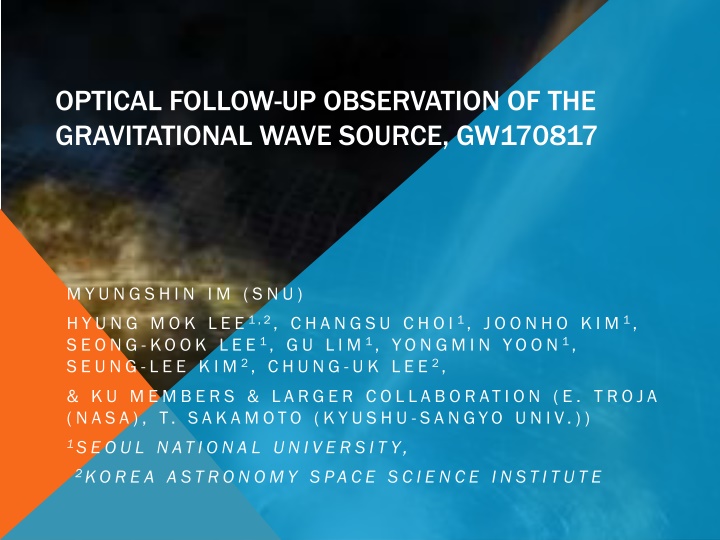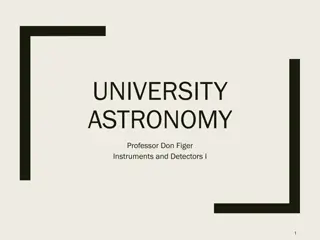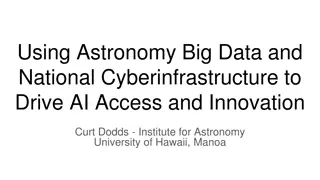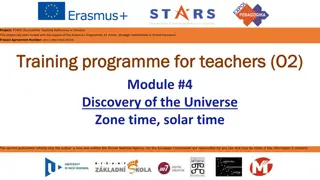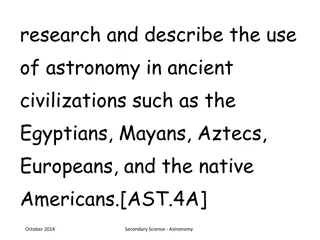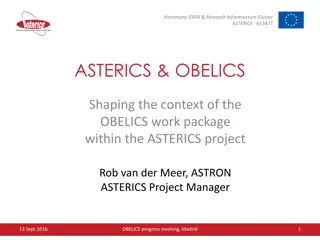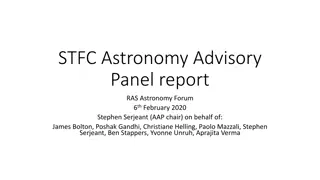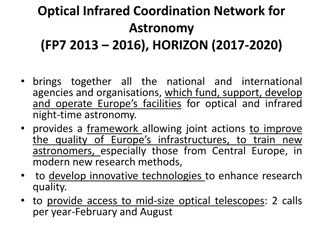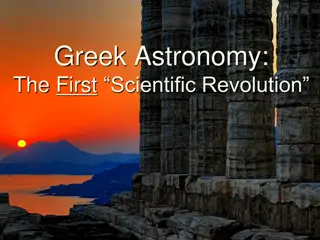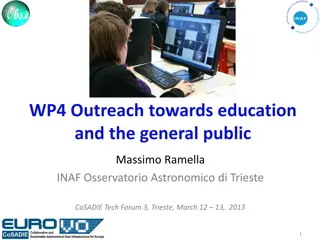Optical Follow-Up Observation of GW170817 and GW Astronomy Milestones
Optical follow-up observations have been instrumental in studying the gravitational wave source GW170817. This event marked a significant milestone in GW astronomy, leading to Nobel prizes and advancements in astrophysical studies. The era of GW astronomy began in 2015 with the detection of GW150914, followed by BH-BH mergers and efforts to identify EM counterparts. Limitations in accurate positioning and redshift/distance measurements have posed challenges, but the search for GW events with EM signals continues. Kilonovae, nova, and the importance of heavy atom production in determining the color of kilonovae have been key topics of study in this field. Bright light curves and the implications for different mergers have been explored, shedding light on the exciting possibilities in astrophysical research.
Download Presentation

Please find below an Image/Link to download the presentation.
The content on the website is provided AS IS for your information and personal use only. It may not be sold, licensed, or shared on other websites without obtaining consent from the author.If you encounter any issues during the download, it is possible that the publisher has removed the file from their server.
You are allowed to download the files provided on this website for personal or commercial use, subject to the condition that they are used lawfully. All files are the property of their respective owners.
The content on the website is provided AS IS for your information and personal use only. It may not be sold, licensed, or shared on other websites without obtaining consent from the author.
E N D
Presentation Transcript
OPTICAL FOLLOW-UP OBSERVATION OF THE GRAVITATIONAL WAVE SOURCE, GW170817 M Y U N G S H I N I M ( S N U ) H Y U N G M O K L E E1 , 2, C H A N G S U C H O I1, J O O N H O K I M1, S E O N G - KO O K L E E1, G U L I M1, YO N G M I N YO O N1, S E U N G - L E E K I M2, C H U N G - U K L E E2, & K U M E M B E R S & L A R G E R C O L L A B O R AT I O N ( E . T R O J A ( N A S A ) , T. S A K A M OTO ( K Y U S H U - S A N GYO U N I V. ) ) 1S E O U L N AT I O N A L U N I V E R S I T Y, 2KO R E A A ST RO N O M Y S PAC E S C I E N C E I N ST I T U T E
THE ERA OF GW ASTRONOMY HAS ARRIVED AT 2015! BH BH- -BH merger BH merger Nobel prize in 2017 Nobel prize in 2017 GW 150914
GW150914 Position accuracy at 600 deg Position accuracy at 600 deg2 2(2500 x full moon) (2500 x full moon) Credit: LIGO
BH-BH merger No light signal is expected No EM counterpart No EM counterpart No accurate position No accurate position No accurate redshift/distance No accurate redshift/distance Limitation on astrophysical studies Limitation on astrophysical studies - - new phenomena (e.g., new phenomena (e.g., kilonova kilonova) ) - - cosmological application ( cosmological application (e.g e.g, H , H0 0) ) No fun for astronomers No fun for astronomers GW event with EM signals desired! GW event with EM signals desired! Credit: A. Simonnet
- - Merger Merger- -nova nova Taken from presentation by M. Tanaka
KILONOVA: BLUE OR RED? DEPENDS ON HEAVY ATOM PRODUCTION Xlan : Lanthanide fraction Kasen et al. (2017, Nature)
LIGHT CURVE (IF RED) At 40 At 40 Mpc r(AB) ~ 20.5 mag r(AB) ~ 20.5 mag i i(AB) ~ 19.0 mag (AB) ~ 19.0 mag z(AB) ~ 17.5 mag z(AB) ~ 17.5 mag J(AB) ~ 18.5 mag J(AB) ~ 18.5 mag Mpc, , Bright enough for Bright enough for 1 1- -m class telescopes m class telescopes NS-NS Merger at D=200 Mpc NS-BH Merger at D=400 Mpc Tanaka, M. et al. (2014, ApJ)
2014 Spring, Korean Astronomical Society Meeting HOW MANY? (2013 PREDICTION) Aasi, J. et al. 2013, arXiv:1304.0670v1 Epoch Epoch Number of BNS Detection Number of BNS Detection 2015 2015 0.03 0.03 2016 2016- -2017 2017 0.3 0.3 O2: 2016.11.30-2017.8.25 2017 2017- -2018 2018 2 2 2019 2019 6 6 O3: 2019, Feb (9 months) Sooner or later, there will be a BNS merger event detection Sooner or later, there will be a BNS merger event detection
OUR FACILITIES FOR EM FOLLOW-UP Korea: Korea: SNU 0.6/1.0m, SOAO 0.6m, SNU 0.6/1.0m, SOAO 0.6m, BOAO 1.8m, DOAO 1.0m BOAO 1.8m, DOAO 1.0m Maidanak Maidanak: : 1.5m Telescope 1.5m Telescope US: LOAO 1 US: LOAO 1- -m m US: McDonald 2.1 US: McDonald 2.1- -m, 0.8m, 0.25m 0.8m, 0.25m m, KMTNet KMTNet 1.6m Telescopes Telescopes 1.6m Australia: Australia: 0.43m LSGT 0.43m LSGT + + iTelescope.Net iTelescope.Net (SSO) (SSO)
2017-08-17 BH merger NS merger
SHORT GRB DETECTION (FERMI/INTEGRAL) Weak GRB 2 sec after GW detection, duration ~2 sec Weak GRB 2 sec after GW detection, duration ~2 sec 10000x weak 10000x weak Credit: NASA
GW170817: NS-NS MERGER OPTICAL COUNTERPART DISCOVERY 8 telescopes in Chile spotted GW counterpart at 11 hours after GW 8 telescopes in Chile spotted GW counterpart at 11 hours after GW detection detection NGC 4993 NGC 4993 at ~40 at ~40 Mpc Mpc (RA:13h09m47s, Dec: (RA:13h09m47s, Dec:- -23d23m02s) 23d23m02s) MMA paper LIGO, Virgo, Partner Astronomy Groups 2017, ApJL
FIRST KOREAN OBSERVATION At 2017 At 2017- -8 8- -18, about 21 hours after the GW detection, the GW EM 18, about 21 hours after the GW detection, the GW EM counterpart was detected by LSGT (0.43m telescope!) counterpart was detected by LSGT (0.43m telescope!) 2017-08-18 10:08:01(UT) GW170817 NGC 4993 Lee Sang Gak Telescope (Siding Spring Observatory) Optical counterpart detection by LSGT
KMTNET FOLLOW-UP OBSERVATION Korea Microlensing Telescope Network: Three 1.6m Korea Microlensing Telescope Network: Three 1.6m telescopes at Southern Hemisphere (exoplanet microlensing) Hemisphere (exoplanet microlensing) telescopes at Southern KMTNet KMTNet SAO telescope started the observation at about 28 hours after the GW SAO telescope started the observation at about 28 hours after the GW detection detection Observations continued till Sept. 9 (B,V,R,I) Observations continued till Sept. 9 (B,V,R,I)
KMTNET IMAGE OF GW170817 KMTNet-SAAO 08-18 KMTNet-SAAO 08-22 / Blue Blue Red evolution Red evolution
KMTNET LIGHT CURVE OF GW170817 Red Brighter Blue Im et al. (in preparation), Troja et al. (2017)
COMPARISON WITH KILONOVA MODEL Mej Mej ~ 0.01 ~ 0.01 Msun Wind model Wind model Msun Kilonova! Troja et al. (2017)
DELAYED X-RAY DETECTION Chandra detection of X Chandra detection of X- -ray counterpart 9 days after GW detection ray counterpart 9 days after GW detection HST (optical) vs. Chandra (X-ray) Credit: NASA
KILONOVA NATURE + X-RAY DETECTION Delayed X Delayed X- -ray counterpart ray counterpart Off Off- -axis short GRB axis short GRB Optical observation Optical observation Kilonova Kilonova nature nature Troja Troja et al. 2017, Nature (9 authors from Korea) et al. 2017, Nature (9 authors from Korea) Multi-color light curve
OFF-AXIS JET OR COCOON? Cocoon Structured Off-axis Jet Credit: NRAO/AUI/NSF/D. Berry
GW170817 HOST GALAXY KMTNet KMTNet, LSGT, HST , LSGT, HST Distance and properties Distance and properties of NGC 4993 as host galaxy of a gravitational wave source, GW of NGC 4993 as host galaxy of a gravitational wave source, GW 170817", 2017, 170817", 2017, ApJL ApJL Im et al. 2017 (Oct. 3, submitted, Oct. 13, accepted), 12 Korean co-authors
NS-NS MERGER HOST GALAXY It should have properties similar to short GRB host galaxy It should have properties similar to short GRB host galaxy ? ~ 108.5 11.8? 10 ??? < ??? < 5 ??? Massive Massive Old, but not too old Old, but not too old No or moderate star formation rate No or moderate star formation rate ? ?? 0 < ??? < 10 25% at r < r_eff (Fong & Berger 2013) (Fong & Berger 2013) Short GRB at outer part Short GRB at outer part Berger (2013), and references therein
NGC 4993 IS ~E (Y YOON) Im et al. (2017) Sersic Sersic index n = 3 index n = 3- -4, B/T = 0.7 4, B/T = 0.7 1.0 1.0 R Reff Age > 2 Age > 2 Gyr eff= 10 = 10 15 (2 Gyr + no star formation + no star formation 15 (2- -3 3 kpc kpc) ) Consistent with short GRB host galaxy property Consistent with short GRB host galaxy property
FUNDAMENTAL PLANE (FP) DISTANCE Velocity dispersion Size Surface brightness (Carter et al. 1988; Beuing et al. 2002; Wegner et al. 2003; Ogandao et al. 2008) Jun et al. (2008) ? 180 ??/??? 17 FP parameter sets ??= 37.7 8.7 ???, ?? ??= 38.4 8.9 Mpc Im et al. (2017)
MULTI-MESSENGER ASTRONOMY GW Gamma-ray +2sec X-ray +9days Radio +16 days UV/Optical/NIR +11hrs
WORLDWIDE EFFORT 3 GW detectors, 70 ground 3 GW detectors, 70 ground- -based obs., 7 space telescopes based obs., 7 space telescopes 45 45 countries, countries, 900+ institutions, 50+ groups, 900+ institutions, 50+ groups, ~3700 76 papers on 2018 76 papers on 2018- -10 10- -16 (7 papers with Korean involvement, www.kilonovae.org) 16 (7 papers with Korean involvement, www.kilonovae.org) ~3700 scientists scientists
MULTI-MESSENGER ASTRONOMY PAPER (MMA PAPER, APJL) Summary of the GW170817 MMA efforts Summary of the GW170817 MMA efforts Total author Total author 3600+(39 authors from KGWG, KASI, SNU, SKKU) 3600+(39 authors from KGWG, KASI, SNU, SKKU) Total 59 pages (Author list: 24 Total 59 pages (Author list: 24 pages, Acknowledgement: 7 pages, Acknowledgement: 7 pages, Tables: 17 pages, Tables: 17 pages) pages) MMA paper LIGO, Virgo, Partner Astronomy Groups 2017, ApJL (Oct. 3, submitted, Oct. 7, accepted)
RESULTS NS NS- -NS merger proof NS merger proof - - mass from GW (1.5 M mass from GW (1.5 M + 1.25 M - - (off (off- -axis?) short GRB signal as predicted axis?) short GRB signal as predicted - - First convincing detection of First convincing detection of kilonova - - host galaxy consistent with NS host galaxy consistent with NS- -NS merger + 1.25 M = 2.75 M = 2.75 M ) ) kilonova (Korean team + world astronomers) (Korean team + world astronomers) NS merger (Korean team + several other groups) (Korean team + several other groups) Cosmological application of GW Cosmological application of GW - - First application of H0 measurement with GW + optical signal (Korean GWG + First application of H0 measurement with GW + optical signal (Korean GWG + LIGO/Virgo) LIGO/Virgo) Search strategy Search strategy - - host galaxy property as a guide (Korean team + several other groups) host galaxy property as a guide (Korean team + several other groups)
IMPLICATION: FIRST SECURE IDENTIFICATION OF THE FACTORY OF GOLD, PLATINUM, URANIUM ETC Efficient neutron capture (r Efficient neutron capture (r- -process) leads to creation of these elements process) leads to creation of these elements 200 earth mass gold, 500 earth mass platinum 200 earth mass gold, 500 earth mass platinum
RESULT OF NS-NS MERGER? How about NS How about NS- -BH merger? BH merger?
RECENT HST OBSERVATION (2017-12-06) Lyman et al. 2018, Nature Astronomy mF606W=26.44 + mF606W=26.44 +- - 0.14 mag 0.14 mag Consistent with off Consistent with off- -axis GRB model axis GRB model X X- -ray observations also reveals fading X ray observations also reveals fading X- -ray counterpart ray counterpart
GC GC- -cluster based distance: 41.65 + cluster based distance: 41.65 +- - 3.00 3.00 Mpc Mpc
NEAR FUTURE PROSPECTS LIGO/Virgo LIGO/Virgo O3 observation at 2019 February O3 observation at 2019 February KAGRA (Japanese GW detector) KAGRA (Japanese GW detector) Burst of GW detections with EM counterpart, expected Burst of GW detections with EM counterpart, expected In Korea, SOGRO detector conceptual study In Korea, SOGRO detector conceptual study Follow Follow- -up facilities are secured: 1m up facilities are secured: 1m- -class telescope, UKIRT, Gemini class telescope, UKIRT, Gemini Epoch Epoch Number of BNS Detection Number of BNS Detection 2015 2015 0.03 0.03 2016 2016- -2017 2017 0.3 0.3 2019 2019 O3 run O3 run BNS 4+ BNS 4+ O2: 2016.11.30-2017.8.25 2017 2017- -2018 2018 2 (0.04 2 (0.04 100) 100) 2019 2019 6 6 O3: 2019, Feb (9 months)
